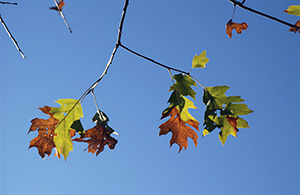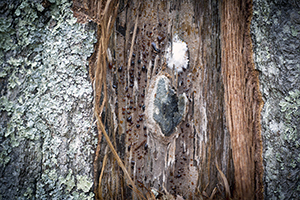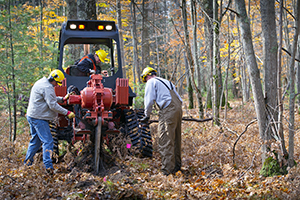Battling oak wilt disease
By KATHLEEN LAVEY
Michigan Department of Natural Resources
In state forests and on urban streets, the oak is a mighty tree. Towering nearly 100 feet tall, it can live up to 150 years and offers plenty of shade under its heavily-leafed, spreading branches.
But oaks – especially trees in the red oak family – face a threat from a disease known as oak wilt, caused by a fungus with microscopic spores that can infect and kill a red oak within weeks.

“The leaves begin to turn brown, with parts of them still green,” said James Wieferich, a forest health specialist with the Michigan Department of Natural Resources. “When the leaves start dropping in the middle of summer, that’s when we get a lot of oak wilt calls.”
Wieferich said there’s good news and bad news about oak wilt.
The bad news: you cannot save a red oak that is already showing symptoms.
The good news: simple actions, such as refraining from pruning oak trees between April 15 and July 15 and covering accidental bark wounds with paint, can help keep healthy trees from being infected.
On city streets, those steps help keep tree loss to a minimum. In state forests, plows and selective cutting help keep the disease at bay.
People who spot a tree with symptoms of oak wilt – in the city or the forest – are encouraged to check the DNR’s interactive oak wilt map at Michigan.gov/ForestHealth to report it.
|

So, what is this infection that can take down a towering oak?
Oak wilt is caused by the fungus Bretziella fagacearum. It spreads from tree to tree by underground root contact, through tiny, sap-feeding beetles that carry spores from fungal pads on infected trees into wounds on healthy oaks.
Spores also can be found on recently cut firewood from trees that died of oak wilt. This is one of the reasons why the DNR and other agencies advise against moving firewood.
Oaks in the red oak family, including black oak, northern red oak and northern pin oak, are most susceptible to the disease, which kills trees by interrupting the flow of sap.
Trees in the white oak group are less susceptible because they have a different internal cell structure that prevents rapid spread of the infection through the tree. Trees in the white oak group have rounded leaf edges and include white oak and swamp white oak.
The highest risk of infection occurs from April 15 through July 15, but it is prudent to avoid pruning or injuring oak trees until they have lost leaves for the winter.
If pruning or removing oaks cannot be avoided during the high-risk period, or a tree gets damaged, immediately cover wounds with tree-wound paint or latex-based paint. Treating tree wounds with paint is not usually recommended; doing so to combat oak wilt is the exception.
|

Infected trees will usually begin to display symptoms beginning in June through September. The symptoms include the leaves showing two colors during these months and rapid leaf drop from the tree’s upper crown.
Those trees are usually easy to spot in a backyard. DNR staffers also are keeping an eye out for oak wilt in state forests and taking measures to stop its spread.
“We prioritize our treatment efforts in new areas where there is not a lot of oak wilt,” said Scott Lint, a forest health specialist with the DNR.
Those areas include Otsego and Cheboygan counties in northern Michigan. In the Upper Peninsula, control efforts are focused on Menominee, Iron and Dickinson counties.
Other priority spots include state campgrounds and trail access sites where people come to enjoy the woods.
“For the rest of the state forest, we prioritize by the quality of the oak,” Lint said. “We tend to prioritize high-quality northern red oak rather than pin oak.”
Once an infection is spotted in a priority area, DNR staffers bring in a piece of heavy equipment known as a vibratory plow. It creates a deep trench to separate the roots of the infected tree from trees outside the perimeter.
“All of the trees within that circle have the potential to become infected and die,” Lint said.
Other oak trees within the circle are cut down. Sometimes they are salvaged for timber; other times they are left in place.
|
Within a treated area, new trees that sprout from stumps are likely to die from oak wilt because they are connected to the infected underground root system, where the disease can linger for a few years. The roots of new oaks that generate from seeds aren’t deep enough to become infected.
“Once we do the plowing, we have removed the risk of oak wilt spreading,” Lint said. “New seedlings that originate from seed will grow in that same area uninfected.”
Tips to avoid oak wilt:
- Don’t prune oaks from mid-April through the summer.
- If oak trees must be pruned or removed during the risk period, or a tree gets damaged, immediately cover wounds with tree-wound paint or latex-based paint.
- Don’t move firewood, especially if it comes from oak wilt-killed trees, as it can harbor the fungus.
- If firewood is suspected of being tainted by oak wilt, cover it with a plastic tarp all the way to the ground, leaving no openings. This keeps beetles away so they can’t move spores onto healthy trees. Leave wood covered until the fall of the year following tree death to keep the disease from spreading.
If the presence of oak wilt is suspected:
Whether in the forest or in urban areas, land managers and property owners taking a few relatively simple steps can prevent oak wilt infection and keep oaks towering over our backyards, city streets and forests for decades into the future.
Check out previous Showcasing the DNR stories in our archive at Michigan.gov/DNRStories. To subscribe to upcoming Showcasing articles, sign up for free email delivery at Michigan.gov/DNR.
/Note to editors: Contact: John Pepin, Showcasing the DNR series editor, 906-226-1352. Accompanying photos and a text-only version of this story are available below for download. Caption information follows. Credit Michigan Department of Natural Resources, unless otherwise noted.
Text-only version of this story.
Beetles: Picnic beetles are shown near Interlochen State Park. The beetles pick up spores of the oak wilt fungus on their bodies, then carry them to healthy trees.
Benzie: An aerial photo shows oak trees infected with oak wilt disease in Benzie County.
Kurzeja: Phillip Kurzeja of the Michigan Department of Natural Resources checks under the bark of an oak tree for pressure pads in Grand Traverse County.
Leaves: A closeup of oak leaves on an infected tree, which are an unusual mix of brown and green, with both colors contained in the leaves.
Pads: Pressure pads, which are a symptom of oak wilt, are shown from Grand Traverse County.
Plow: Michigan Department of Natural Resources forest health specialist Scott Lint runs a vibratory plow treatment around an oak wilt-infected tree in the Manistee National Forest near Wellston./
|